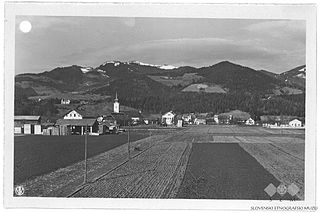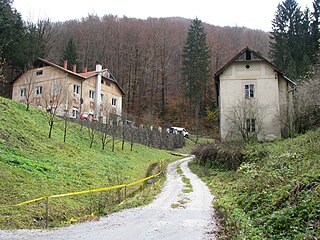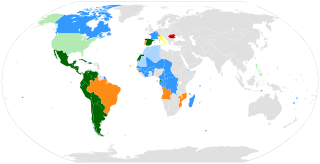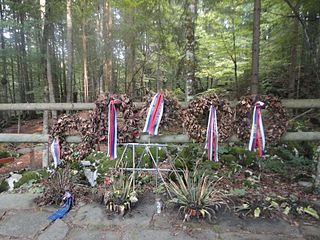
Bistrica ob Sotli is a settlement in eastern Slovenia. It is the seat of the Municipality of Bistrica ob Sotli. The settlement lies on a river terrace above the right bank of the Sotla River. The area traditionally belonged to the region of Styria. It is now included in the Lower Sava Statistical Region; until January 2014 it was part of the Savinja Statistical Region. The settlement includes the hamlets of Čehovec, Koče, and Marof.

Bukovžlak is a settlement in the City Municipality of Celje in eastern Slovenia. It lies on the eastern outskirts of Celje, just north of Teharje. The area was traditionally part of the Styria region. It is now included with the rest of the municipality in the Savinja Statistical Region.

Šmartno pri Slovenj Gradcu is a settlement in the City Municipality of Slovenj Gradec in northern Slovenia. The area was traditionally part of Styria. The entire municipality is now included in the Carinthia Statistical Region.

Zgornji Otok is a settlement in the Municipality of Radovljica in the Upper Carniola region of Slovenia.

Vincarje is a settlement in the Municipality of Škofja Loka in the Upper Carniola region of Slovenia.

Brce is a small settlement in the hills west of Ilirska Bistrica in the Inner Carniola region of Slovenia.

Dolenje pri Jelšanah is a village north of Jelšane in the Municipality of Ilirska Bistrica in the Inner Carniola region of Slovenia, next to the border with Croatia. The settlement includes the hamlets of Dolnji Kraj, Gornji Kraj, and Vrh Žloštajna.

Harije is a village in the hills west of Ilirska Bistrica in the Inner Carniola region of Slovenia.

Huda Jama is a settlement east of Laško in east-central Slovenia. The area was traditionally part of the Styria region. It is now included with the rest of the Municipality of Laško in the Savinja Statistical Region.

Dol is a small settlement in the Upper Dreta Valley in the Municipality of Gornji Grad in Slovenia. Traditionally the area belonged to the Styria region and is now included in the Savinja Statistical Region.

Ples is a settlement in the hills above the right bank of the Sotla River in the Municipality of Bistrica ob Sotli in eastern Slovenia. The area was traditionally part of Styria. It is now included in the Lower Sava Statistical Region; until January 2014 it was part of the Savinja Statistical Region.

Mostec is a village in the Municipality of Brežice in eastern Slovenia. The area was traditionally part of Styria. It is now included in the Lower Sava Statistical Region.

Olešče is a settlement in the Municipality of Laško in eastern Slovenia. It lies in the hills east of Laško. The area was traditionally part of the Styria region. It is now included with the rest of the municipality in the Savinja Statistical Region.

Bezovica is a small settlement in the Municipality of Vojnik in eastern Slovenia. The area was traditionally part of the Styria region. It is now included with the rest of the municipality in the Savinja Statistical Region.

Dovže is a village in the Municipality of Mislinja in northern Slovenia. The area was traditionally part of Carinthia. It is now included in the Carinthia Statistical Region.

Bele Vode is a settlement in the Municipality of Šoštanj in northern Slovenia. It lies in the Mozirje Hills northwest of the town of Šoštanj. The area is part of the traditional region of Styria. The entire municipality is now included in the Savinja Statistical Region. The settlement includes the hamlets of Kloše, Punčkov Vrh, Visočki Vrh, and Zaloka.

Zabukovica is a settlement in the Municipality of Žalec in east-central Slovenia. It lies in the hills south of Žalec. The area is part of the traditional region of Styria. The Municipality of Žalec is included in the Savinja Statistical Region. Zabukovica includes the hamlets of Kurja Vas, Močle, Odele, Podvine, Porence, Slovenski Dol, Sončni Hrib, and Zabukovška Vas.

Marija Reka is a settlement in the Municipality of Prebold in east-central Slovenia. It lies in the hills south of Prebold. The area is part of the traditional region of Styria. The municipality is now included in the Savinja Statistical Region. The settlement includes the hamlets of Mala Reka, Velika Reka, and Jelenca.

Čužnja Vas is a village in the hills southeast of Mokronog in the Municipality of Mokronog-Trebelno in southeastern Slovenia. The area is part of the historical region of Lower Carniola and is now included in the Southeast Slovenia Statistical Region. The village includes the hamlets of Jerenga, Sela, and Zapadeži.

Breg is a settlement on the left bank of the Sava River in the Municipality of Sevnica in central Slovenia. The area is part of the historical region of Styria. The municipality is now included in the Lower Sava Statistical Region. The settlement includes the hamlets of Gradišče, Jelše, and Zagradec.
















